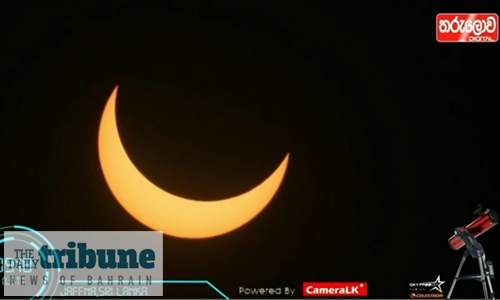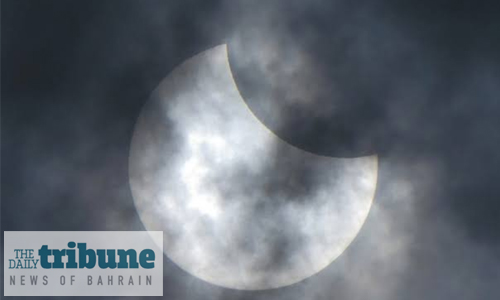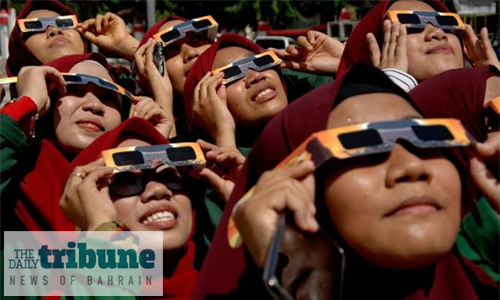The last celestial treat of 2019
As the celestial dance started unwinding slowly across the morning sky of Bahrain, there were countless eyes gazing at the horizon. Joy, fear, anxiety, you name it and they had them all as the Sun, Moon and Earth slowly started their full, jaw-dropping, knee-buckling, emotionally-overloading spectacle in its totality.
However, for Bahrainis, being outside the path of totality, the experience was not full with the Moon only partially covering the Sun’s disk creating a less dramatic but still impressive show. The annular or “ring-shaped” phase of the eclipse was visible only at those places where the Sun, Moon and Earth got aligned in a perfect straight line.
Annular eclipse occurs when the Moon covers the Sun’s centre, leaving the Sun’s visible outer edges to form a blazing “ring of fire” or fierce sunlight or annulus. Had the moon been closer to earth, it would have been a total eclipse with it completely blocking out the sun.
Yesterday, during the eclipse, the apparent size of the Moon was 3 per cent smaller than that of the Sun and was at a distance of 384,200 km from Earth.
Partial in Bahrain
In Bahrain, the celestial glide began at 05:32 am local time below the horizon with the silhouette of the moon moving at a direction of 110° and -11.2° altitude. The eclipse reached its deepest point at 06:36 am at 117° angle and 2.2° altitude. The partial eclipse concluded at 07:49 am as the Moon left the sun’s edge at an angle of 126° and 15.9° altitude.
The entire eclipse event lasted for about 3 hours and 13 minutes, though not all of it were visible from Bahrain. In Bahrain, the total duration was 01 hour 26 minutes 43 seconds. Morning assemblies were cancelled at schools throughout in the Kingdom as warnings were also given to people to not to watch the eclipse with naked eyes.
The education ministry has confirmed that schools will function as usual.
First in Saudi
In the Middle East, the phenomenon presented itself on the horizon early morning, while in southern India it happened at mid-morning. In Indonesia, the strange sight occurred early afternoon and towards sunset in the Philippines.
Preparations to witness the event were elaborate all across the Middle East with the UAE also holding ‘eclipse’ prayers at mosques across the country.
The General Authority for Islamic Affairs and Endowments held ‘Kusoof ’ prayer at 7.40 am at Sheikh Zayed mosques and other major ones. The UAE also organised several free-for-all events across the nation in association with the UAE Space Agency and observatories.
Ends in Guam
Since the amount of solar disk hidden by the moon in a partial eclipse depends on how far inside the penumbral shadow an observer is, those wanting to enjoy that fleeting seconds of wonderment, inside the shadow of the moon, were stationed along a 118-kilometre wide path stretching from Saudi Arabia to the Philippines.
Only those in Qatar, the UAE, Oman southern India, Sri Lanka, Indonesia, Singapore, Malaysia, and the tiny US territory of Guam managed to see the “ring of fire”.
While these types of eclipses occur every year or two, they are only visible from a narrow band of Earth each time and it can be decades before the same pattern is repeated.
Depending on weather conditions, this year’s astronomical phenomenon was set to be visible from the Middle East across southern India and Southeast Asia before ending over the northern Pacific.
8 minutes to cross India
The first place to see the annual eclipse was 220 kilometres northeast of Riyadh, where it began at 6:34 am local time (0334 GMT), and the “ring of fire” phase lasted 2 minutes and 59 seconds.
Travelling at a ground speed of about 1.1 kilometres/second, it took the ant umbral shadow 8 minutes to cross India. The immense opportunity to stand in the shadow of the moon lasted for a maximum of 3 minutes and 39.5 seconds at the Indonesian island of Paulo Gin Besar, which was also the longest yesterday.
Southern India
In southern India, preparations were elaborate with government officers, courts, schools and colleges declaring a public holiday.
Mumbai even cancelled a first-class cricket match between Mumbai and Rajkot. However, in New Delhi, cloud blocked the view with Prime Minister Narendra Modi tweeting his disappointment, although the view would have been partial.
“Like many Indians I was enthusiastic about solareclipse 2019,” Modi said. “Unfortunately, I could not see the Sun due to cloud cover but I did catch glimpses of the eclipse in Kozhikode and other parts on live stream.”
In Indonesia, hundreds of people gathered outside Jakarta Planetarium to watch the event using protective glasses supplied by the planetarium, hoping for clear skies at the time of maximum eclipse.
“I could see the eclipse this morning and now am very excited to see the peak though now it is cloudy,” said Chandra Ayu Dewi, 39, who arrived at 7:00 am with her children. Outside the narrow band where the “Ring of fire” effect can be observed, skywatchers would see a partial solar eclipse.
Related Posts



